Abstract
Equinoctial asymmetry of the range of the solar quiet day variation (Sq) of the horizontal geomagnetic field (H) has been found in some low latitude geomagnetic observatories. This study conducted an investigation of its latitude distribution and the relationship with the solar cycle by using the H field measurements from six observatories along the 120° E meridian chain in the years 1957–2013. Results illustrate a significant equinoctial asymmetry of the SqH range at all observatories. Three main features were identified. First, the signature of the equinoctial asymmetry of the SqH range is opposite for observatories located at the northern and southern sides of the Northern Hemisphere Sq current focus. It shows larger values around spring than autumn equinox at southern observatories, and the converse is seen at northern observatories. Second, the asymmetry increases with the distance from the Sq current focus, suggesting the stronger sensitivity of the distant observatories than observatories around the focus. The result of linear fitting presents a positive dependence of the asymmetry coefficient on geographic latitude, with a reversal of the asymmetry occurring at 28.1° N near the focus of the average Sq current. Third, there is no obvious dependence of the equinoctial asymmetry of the SqH range on solar activity, suggesting a possible cause from some regional factors related to the ionospheric dynamo process.
1. Introduction
During geomagnetic quiet days, a regular diurnal variation—with an amplitude of a few tens of nanotesla (nT)—of the Earth’s geomagnetic field, known as the solar quiet day variation (Sq), is observed at middle and low latitudes. It is primarily originated from two current whorls driven by atmospheric tidal winds and controlled by the ionospheric dynamo currents, flowing in the E region of the ionosphere at altitudes of 90–150 km: counterclockwise in the northern hemisphere and clockwise in the southern hemisphere [1,2,3,4]. Its daily range (or amplitude), phase (or shape), and the foci (or centers) of the Sq’s ionospheric equivalent current exhibit variations on multiple timescales—diurnal, seasonal, and over a solar cycle [5,6,7,8].
Seasonal variations of Sq have been extensively studied in the past decades. The Sq field amplitude shows maxima during equinoctial months at low and equatorial latitudes [1,9,10,11]. Similar equinoctial peaks of the Sq current intensity were also identified in simulation results, which were possibly caused by tidal waves in the lower atmosphere [12,13,14,15]. Moreover, the position of the Sq current focus also showed seasonal shifts in latitude and local time (LT) during equinoctial months [16,17,18,19,20,21,22,23,24].
Prior investigations generally combined spring and autumn months to represent the “equinox season”, as defined by Lloyd (1874) [25]. However, a few studies differentiated between spring and autumn months. Howe (1950) [26] found that the amplitude of the horizontal (H) component of Sq (SqH) was smaller in September than in March at the Honolulu observatory (HON, 21.3° N, 201.9° E). Wulf (1963, 1965) [27,28] compared seasonal variations of the SqH range between the HON, San Juan (SJG, 18.4° N, 293.9° E), and Tucson (TUC, 32.2° N, 249.3° E) observatories and found a larger maximum in March than in September at HON and SJG, but a reversed situation at TUC. He suggested that it was caused by an anomalous seasonal variation of the large-scale lower-ionospheric circulation. Analyzing data from eighteen observatories located at low-to-high latitudes, Chulliat et al. (2005) [29] confirmed the significant SqH equinoctial asymmetry at HON and TUC. They suggested that this asymmetry was only weakly correlated with solar activity but was more likely the result of the ionospheric dynamo induced by seasonal asymmetry of lower-thermospheric winds. Recently, similar SqH equinoctial asymmetry was reported by Falayi (2014) [30] at an equatorial observatory, Addis Ababa (AAE, 9.0° N, 38.8° E). Furthermore, equinoctial asymmetry of the Sq equivalent current also has been found by the method of spherical harmonic analysis. Takeda (2002) [31] observed different phases of the Sq equivalent current in March and September and attributed this to the equinoctial asymmetry of tidal winds in the upper atmosphere. Yamazaki et al. (2010) [14] examined the month-to-month variation of the Sq current intensity in East Asia and discovered a spring–autumn asymmetry, with a larger intensity in spring.
Obviously, based on few stations in previous ground observations, the understanding of the detailed features of the SqH equinoctial asymmetry is limited in former studies. Its latitudinal distribution and its relationship with the current center and solar activity need to be better clarified. Therefore, the purpose of this study was to investigate the latitudinal distribution of the equinoctial asymmetry of the range of SqH by using hourly observations of the horizontal component of the geomagnetic field, acquired at six geomagnetic observatories located along the 120° E meridian chain. Their proximity locations allow us to examine more detailed characteristics of the equinoctial asymmetry of the SqH at the Sq current region of the Northern Hemisphere, located in East Asia, than previous studies. Additionally, we investigated the relationship between the SqH and the solar activity using data from the years 1957–2013.
2. Data and Calculations
In this study, we used hourly measurements of the horizontal component of the geomagnetic field from six geomagnetic observatories located in the Northern Hemisphere along the 120° E meridian chain. Five are in China—Beijing Ming Tombs (BMT), Lanzhou (LZH), Chengdu (CDP), Wuhan (WHN), and Guangzhou (GZH)—and one—Muntinlupa (MUT)—is in the Philippines. The five Chinese observatories are member stations of the Chinese meridian project, more information on which can be found on the website: “https://data.meridianproject.ac.cn/about-us/” (accessed on 18 September 2021). The MUT station is part of the 210 magnetic meridian chain, listed in the catalogue of stations on “https://stdb2.isee.nagoya-u.ac.jp/mm210/station.html” (accessed on 18 September 2021). Here, the data of these stations are downloaded from the World Data Center for Geomagnetism (Edinburgh) on site: “ftp://ftp.nmh.ac.uk/” (accessed on 18 September 2021). As declared by WDC (Edinburgh), the geomagnetic data are collected from operating observatories and INTERMAGNET (International Real-time Magnetic Observatory Network), and keep the data policy of IAGA (International Association of Geomagnetism and Aeronomy) to publish filtered one-minute data and one-hour data. As known from the introduction of the observatories on WDC (Edinburgh) and INTERMAGNET, the instrumental system including vector fluxgate magnetometer and scalar magnetometer is equipped to obtain the absolute observed values of the magnetic field.
Theses six observatories are distributed over about 25° in geographic latitude (14–40° N) with an interval of 5–8°, except between CDP and WHN. Their coordinates are listed in Table 1. Figure 1 shows their positions relative to the Northern Hemisphere Sq current system. This Sq current diagram describes an average ionospheric equivalent current, which is derived by the commonly used spherical harmonic analysis technology and by using the data of the yearly averaged solar quiet day variation of observatories in geographical longitude from 90 to 130 degrees in 2000—hence, with no focusing on its daily and monthly variation. CDP and WHN are near the focus of the Sq current. BMT and LZH will hereafter be referred to as “northern stations”, while GZH and MUT will be referred to as “southern stations”.

Table 1.
Coordinates and time coverage of the geomagnetic observatories used in this study.
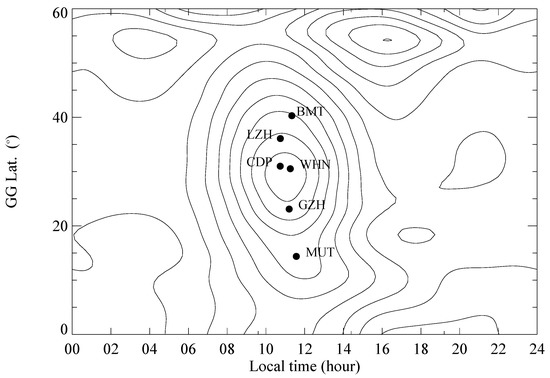
Figure 1.
Schematic diagram of the geomagnetic observatories’ locations used in this study, along the 120° E meridian chain, relative to the Northern Hemisphere solar quiet (Sq) current focus. “GG Lat”. represents the geographic latitude.
Figure 2 shows the variation of solar radio flux at 10.7 cm (F107) in solar flux units (1 sfu = 10−22 W m−2 Hz−1) [32] and the yearly coverage of the geomagnetic field measurements used in this study. As we can see, the full dataset covers five solar cycles from 1957 to 2013. None of the observatories were operational during the complete period; however, time coverage is sufficient for investigating the latitudinal distribution of the SqH equinoctial asymmetry because of the good temporal overlap between the northern stations (1995–2007) and between both southern stations (1963–1972). These common periods are used to compare observatories on the same side of the Sq current focus.
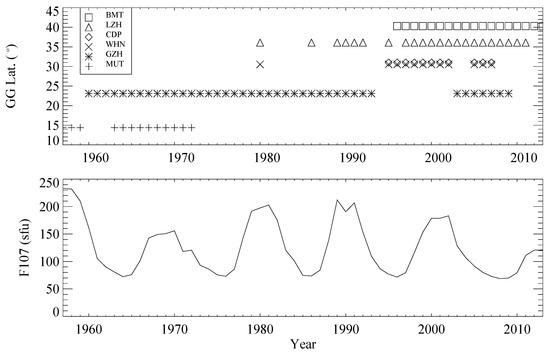
Figure 2.
(Top): Yearly coverage of the observations used in this study at each observatory. (Bottom): Yearly averages of the 10.7 cm solar radio flux (F107) over the full time period (1957–2013), downloaded from the ftp server: ftp://ftp.gfz-potsdam.de/pub/home/obs/Kp_ap_Ap_SN_F107 (accessed on 18 September 2021).
To calculate SqH, hourly data are first accumulated to obtain daily values. The baseline value derived from the average “midnight” values between 23:00 and 02:00 LT and the secular changes calculated with a detrending method [33] are both removed from the daily measurements. Then, the SqH is calculated by averaging the results of the five international quiet days in each month [1], which is derived by GFZ Potsdam from the Kp index. From the daily SqH values, we further derive monthly and yearly averaged SqH values, shown in Figure 3. Marked diurnal and seasonal variations are clearly visible, and the standard deviations (d) as an error value for each hour are also plotted in red bars. In the right panel of Figure 3, the diurnal variations of the yearly averaged SqH of the southern stations (MUT and GZH) show a marked enhancement around 12:00 LT, with a magnitude decreasing closer to the Sq current focus. While, the strong enhancement as seen at noontime at the equatorial station MUT clearly reflects the contribution of equatorial electrojet (EEJ), which also could produce an impact on low latitude stations and could probably result in the misunderstanding of the characteristics of the Sq focus [11,34] However, curves of the diurnal variations are much more smooth at “central” stations (WHN and CDP). Conversely, the diurnal variation pattern of the yearly averaged SqH at northern stations LZH and BMT shows a strong decrease between 09:00 and 12:00 LT.

Figure 3.
Diurnal variations of monthly (left panel), yearly (right panel) averaged SqH and associated standard deviations d (in red short lines) at each observatory, sorted by latitude from north (top) to south (bottom) of the Sq current focus.
In the left panel of Figure 3, average monthly SqH, derived from all available years in each station, are contoured, which shows the peak amplitude of the SqH in the equinoctial months. Additionally, the extreme values appear to be drifting in LT, occurring increasingly late from winter to summer at southern stations but early at northern stations. These combined features can fully correspond to the universal time (UT) variability of the Sq and to its ionospheric dynamo current [2,33,35]. Additionally, the SqH amplitude is clearly different between spring and autumn, presenting the asymmetry between the equinoxes.
Next, daily ranges of the monthly average of the SqH over 1957–2013 are calculated as the difference of the extremes: A = Hmax − Hmin, plotted with black curves in Figure 4. They show significant month-to-month variation and a noticeable 11-year variation corresponding to the solar cycle, as shown by the 10.7 cm solar radio flux (F107 index) (Figure 4, top). It is similar to the variation of the intensity and focus of the Sq current and the correlation with solar activity [1,36,37,38,39].
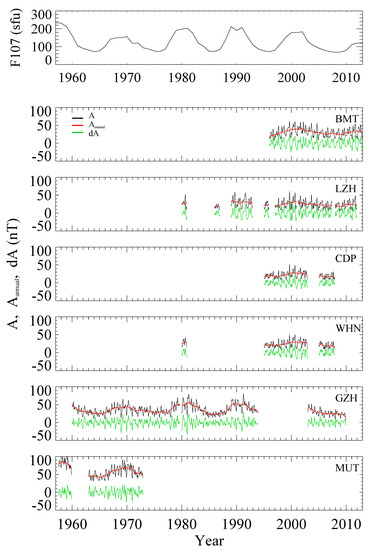
Figure 4.
(Top): Yearly averaged F107 index (1957–2013). (Bottom): Month-to-month variations at each observatory of the SqH daily range (A, black curves); 12-month smoothing of the SqH daily range (Aannual, red curves) and their variability (dA, green curves).
Then, the annual value should be calculated to remove the contribution of the solar cycle on A. As is well known, the method of moving average is a common low-pass filter technique. The effect of the moving window size could not be neglected [11,40,41,42]. From their analysis, for a signal with period T, using 2T as the moving window was more effective in eliminating the periodic T signal than a 1T moving window. Therefore, we performed the analysis with both a 12-month and 24-month moving window, and we confirm that there is no essential difference between the results of these two windows. Thus, in this study, the 12-month moving window was chosen and derives the 12-month smoothed SqH range, noted with Aannual and shown by red curves in Figure 4, in good agreement with the F107 index. The month-to-month range variability is finally derived as a residual: dA = A − Aannual, and it is plotted in Figure 4 with green curves, which show successful removal of the solar activity contribution.
3. Results
The residual dA is then used to investigate seasonal variations of the SqH daily range. In the left panel of Figure 5, monthly dA values derived for each year are plotted for each observatory (superimposed black curves). While the spread of the black curves suggests only small year-to-year variations, marked seasonal variations occur every year. The dA value reaches peak around the equinoxes and is smallest in winter at all observatories, including CDP and WHN located near the Sq current focus. The right panel in Figure 5 shows the average dA variations, the associated standard deviations (SD) d, and the standard error of the mean (SEM, where SEM equals , and n is the number of the stacked curves) [11,40] for each month. Seasonal variation—equinox maximum and winter minimum—is clearly visible at each observatory. Yearly dA ranges (R) are calculated as the difference of the extreme monthly values. We obtain R values of 27.4, 23.8, 22.3, 30.4, 30.0, and 29.4 nT for MUT, GZH, WHN, CDP, LZH, and BMT, respectively, indicating small differences between the observatories. Corresponding monthly standard deviations (d) are within 4.4–12.0, 4.7–8.0, 3.3–6.0, 3.4–7.3, 3.7–7.9, and 4.0–7.7, respectively. This indicates significant monthly variations of dA from year to year.
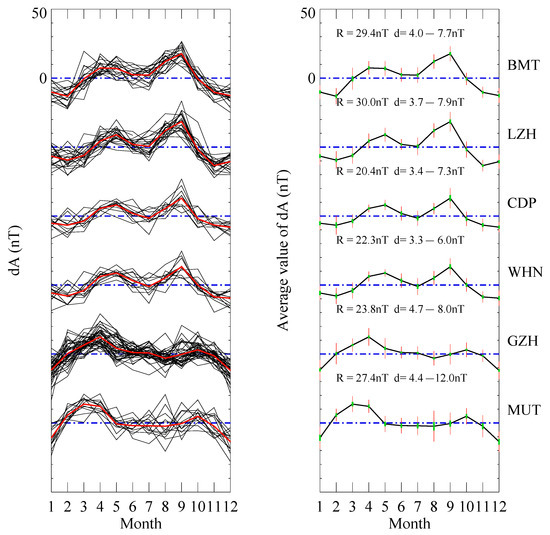
Figure 5.
Seasonal variations of the SqH range (dA) over 1957 to 2013. Left panel: stacking curves of the monthly dA for all available years at each observatory. Right panel: average dA over all available observation years, associated standard deviations d (in red short lines), and SEM (in green bars); values of the yearly range R and of the standard deviation d are indicated.
Equinoctial asymmetry in each year is then defined as the difference of dA averages around the spring (March–April) and autumn (September–October) equinoxes: AA = − . To represent the equinoctial asymmetry variability, an “asymmetry coefficient” is further defined as (dAautumn − dAspring)/(dAautumn + dAspring), and its values at each observatory are shown in Figure 6. By construction, the asymmetry coefficient absolute values cannot exceed . A positive value of AA or of the asymmetry coefficient indicates a greater SqH range in autumn than in spring (red bars), while negative values (blue bars) show reversed asymmetry, with smaller SqH range in autumn than in spring.
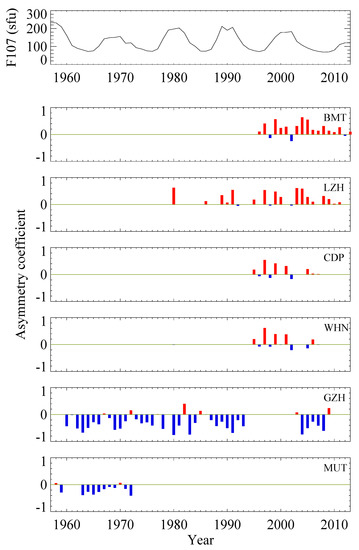
Figure 6.
(Top): yearly averaged F107 index over the period from 1957 to 2013. (Bottom): Equinoctial asymmetry coefficient calculated at each observatory for years with available observations and shown in red and blue bars for the positive and negative values respectively.
The asymmetry coefficient is generally large—regardless of the year or the observatory—reaching, for example, −80% at GZH in 1980. The latitudinal dependence of the equinoctial asymmetry is clearly seen in Figure 6. Most notably, variations of the asymmetry coefficient exhibit the same behavior at observatories located on the same side of the SqH current focus. Additionally, the asymmetry coefficient, generally positive at northern observatories (with a few exceptional years that displayed negative values, as shown in the blue box—for example, in years 1998, 2002, and 2012 at BMT station), changes sign around the Sq current focus (near WHN) and becomes mostly negative at southern observatories (also with a few exceptions that displayed positive values, as shown in the red box—for example, in years of 1958 and 1970 at MUT station). This means that dA is usually larger in spring than in autumn in most years at southern observatories but that the situation is reversed at northern observatories. Moreover, it is also noticed that the intensity of the asymmetry coefficients is very similar between both northern stations BMT and MZL; however, for the southern stations, it is obviously a smaller value in the equator station MUT than in the GZH station, probably related to the EEJ.
When comparing with solar activity, equinoctial asymmetry is quite stable at each observatory. Asymmetry values are mostly negative at southern observatories and positive at northern observatories. Obviously, they do not appear to depend on solar cycle, as increases or decreases in the asymmetry coefficient seem to occur during any phase of the solar cycle (Figure 6). For example, large asymmetry coefficient values are found during high solar activity years—negative in 1969 at GZH and positive in 1980 at LZH—or during low solar activity years, such as 1964 at GZH. Similarly, large values are found during both the descending—in 1983 at GZH or in 2005 at BMT and LZH—and ascending—in 1998 at BMT—phases of the solar cycle. In addition, a few near-zero asymmetry coefficient values are recorded at each observatory. About ten percent of cases from all measurements show values of the asymmetry coefficient that are less than 0.05. This implies that in these years the SqH range is comparable in spring and in autumn.
Figure 7 shows the variations (black dots) and SEM (red bars) of the equinoctial asymmetry AA and of the asymmetry coefficient—both averaged at each observatory over all available measurements—as a function of geographic latitude. The linear fit to the asymmetry coefficient is also shown (green line in the right panel), which has a median value of the errors of A and B (evaluated from the differences between the linear fit value and the measurement) of about −1.14 and −7.54, respectively. Equinoctial asymmetry is clearly visible along the meridian chain: the maximum value of the averaged AA is about −4 nT at “southern station” (GZH) and 5 nT at “northern station” (BMT), and the minimum value is about 1.5 nT presented at “central stations” (WHN and LZH). Accordingly, the maximum averaged asymmetry coefficient is about ±30%, and the minimum value is about 10%. Both quantities increase with geographic latitude and with increasing distance between the observatory and the Sq current focus, possibly suggesting that the distant observatories are more sensitive to the asymmetry mechanism than those close to the Sq current focus. Remarkably, a reversal of the equinoctial asymmetry sign is seen between the northern (positive) and southern (negative) observatories. Additionally, the latitude of the reversal is about 28.1°, which is located near the focus of the focus of the average Sq current (as seen in Figure 1) because of the linear fitting between the asymmetry coefficient and the geographic latitude. Notably, this reverse latitude is only a statistical average result from all the data. The linear fitting results will generally change if the SEM and the confidence interval are considered. After doing some tests with different confidence intervals, we found little change in coefficient A, suggesting the stability of the latitudinal trend of the equinoctial asymmetry of the SqH. Moreover, there is obvious fluctuation in coefficient B, implying the variability of the reversal latitude under different levels of the equinoctial asymmetry of the SqH.
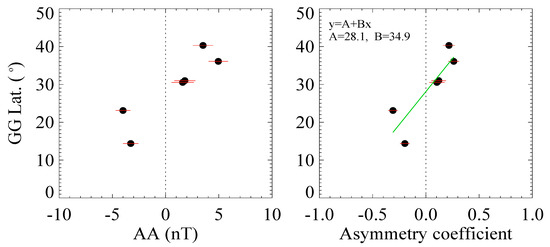
Figure 7.
Dependence of the averaged equinoctial asymmetry AA and averaged asymmetry coefficient on geographic latitude. Red bars represent the SEM. Green curve in the right panel is the linear fit on the asymmetry coefficient, with fitting parameters indicated in the corner.
4. Discussion
Wulf (1963, 1965) [27,28] reported opposite signs of the SqH equinoctial asymmetry at HON and TUC and suggested that the meridional shift of the Sq current focus could cause this asymmetry. For the month-to-month changes of the Sq current focus position, Gupta (1973) [17] examined the meridional movement of Sq foci during the solar maximum of 1958 and found month-to-month shifts with latitude for both the northern and southern Sq foci. Tarpley (1973) [18] detected that the northern focus shifts southwards during autumn months, then northwards in winter. He suggested that this seasonal movement might be caused by the semiannual variation of the electrojet amplitude, induced by different seasonal changes at equatorial and middle–high latitudes. Vichare et al. (2017) [43] also found a drift toward lower latitudes of the Sq focus from March to September.
However, in terms of ionospheric dynamic processes, equinoctial asymmetry of Sq variations shows a strong relationship with the geomagnetic field, ionospheric conductivity, and tidal wind fields [31,44]. The correlation of the asymmetry with seasonal variations of lower-thermospheric winds and lower-ionospheric conductivity was discussed in numerous studies [27,28,29,30]. Obvious equinoctial asymmetry of electron and ion temperatures, ionospheric plasma density, and plasma drifts were also reported [45,46,47,48,49] and might be related to the marked equinoctial asymmetry of thermospheric winds [47,50]. Additionally, the asymmetry of vertical plasma drifts—mainly driven by E and F regions’ neutral wind dynamo processes—has been observed and simulated [51,52,53]. Ren et al. (2012) [53] suggested that equinoctial asymmetry of the migrating semidiurnal tide and semiannual oscillation of the migrating diurnal tide in the tropical mesosphere–lower thermosphere region might be the principal drivers of the vertical plasma drift asymmetry.
In this study, we have shown that the SqH equinoctial asymmetry does not depend on solar activity (Figure 6). This implies a possible connection with regional factors caused by the ionospheric dynamo process. As is known, the Sq variation and the equivalent ionospheric current both show a strong longitudinal dependence [54,55,56]. Simulating the combined effects of the geomagnetic axis tilt and the Sq current magnetic anomaly, Xu et al. [55] suggested that longitudinal dependence of the Sq current is mainly caused by the geomagnetic field. This result was confirmed by Sager et al. [57]. Moreover, Ren et al. [53] analyzed the effect of the geomagnetic field on longitudinal variations of ionospheric vertical plasma drifts. They simulated ionospheric vertical plasma drifts driven by the migrating diurnal tide at 600 km around the equinoxes. Their results showed a significantly weaker longitudinal asymmetry in a coaxial central dipole field than in a realistic geomagnetic field, suggesting the importance of the geomagnetic field in the ionospheric dynamo process.
In summary, the SqH equinoctial asymmetry is a complex phenomenon with multiple causes, such as the latitudinal movement of the Sq current focus, lower thermospheric winds, and the ionospheric dynamo process. In this study, we found that the sign of the equinoctial asymmetry is generally stable at a given observatory—positive north of the Sq current focus and negative at southern observatories.
5. Conclusions
In this study, measurements of the H component of the geomagnetic field acquired at six magnetometer observatories along the 120° E meridian chain in the years 1957–2013 were used to investigate the Sq range equinoctial asymmetry. Monthly values of the SqH range dA show large year-to-year variations at each observatory, but yearly averaged Sq range values (R) are comparable at all observatories. Equinoctial asymmetry is generally significant and positively correlated with geographic latitude. We identify three main features. First, the sign of the equinoctial asymmetry is opposite on the northern and southern sides of the Sq current focus, but the asymmetry is consistent at all observatories on the same side of the focus. SqH range maxima occur in spring at southern observatories but in autumn at northern observatories. Second, equinoctial asymmetry varies linearly with geographic latitude, increasing with increasing distances from the Sq current center, and its sign reverses at around 28.1° N, located near the focus of the average Sq current. This reversion latitude fluctuates in a range of 18 to 38 degrees when different confidence intervals of asymmetry coefficients are considered in the fitting procedure, reflecting the variability of the reversal latitude under different levels of the equinoctial asymmetry of the SqH. Third, the range and sign of the SqH equinoctial asymmetry do not appear to depend on solar activity. This suggests a possible origin in regional factors related to the ionospheric dynamo process. Further research is needed to investigate such issues as the latitudinal properties of the asymmetry at other longitudes or mechanisms that determine the sign of the asymmetry.
Author Contributions
Conceptualization, Y.W. and L.L.; methodology, Y.W.; software, Y.W.; validation, Y.W., L.L. and Z.R.; formal analysis, Z.R.; investigation, Y.W.; resources, Y.W.; data curation, Y.W.; writing—original draft preparation, Y.W.; writing—review and editing, L.L. and Z.R.; visualization, Y.W.; supervision, L.L.; project administration, Y.W.; funding acquisition, Z.R. All authors have read and agreed to the published version of the manuscript.
Funding
This research was funded by the National Key R&D Program of China (Grant No. 2018YFC1503504-03), IEF Grant of CEA (Grant No. 2021IEF0709), and the APSCO Earthquake Research Project Phase II and ISSI-BJ project: Integrating Satellite and Ground Observations for Earthquake Signatures and Precursors, the National Natural Science Foundation of China (41774161), the Open Research Project of Large Research Infrastructures of CAS—“Study on the interaction between low/mid-latitude atmosphere and ionosphere based on the Chinese Meridian Project”, and the Meridian Project of China provided funding in the geomagnetic chain, respectively.
Institutional Review Board Statement
Not applicable.
Informed Consent Statement
Not applicable.
Data Availability Statement
The data used in this study are available from the World Data Centre for Geomagnetism in Kyoto, Edinburgh, and GFZ: http://wdc.kugi.kyoto-u.ac.jp, ftp.nmh.ac.uk, and ftp://ftp.gfz-potsdam.de/pub/home/obs/Kp_ap_Ap_SN_F107 (accessed on 18 September 2021).
Acknowledgments
The authors are grateful for all available data from the respective organizations. We thank Wenyao Xu of IGGCAS for his comments and suggestions, and we are sincerely grateful to the reviewers for their time, effort, and constructive remarks regarding the improvement of our work.
Conflicts of Interest
The authors declare no conflict of interest.
References
- Chapman, S.; Bartels, J. Geomagnetism; Oxford University Press: New York, NY, USA, 1940. [Google Scholar]
- Campbell, W. The regular geomagnetic-field variations during quiet solar conditions. In Geomagnetism; Jacobs, J.A., Ed.; Elsevier: New York, NY, USA, 1989; Volume 3. [Google Scholar]
- Richmond, A.D. Modeling the ionsphere wind dynamo: A review. PAGEOPH 1989, 131, 413–435. [Google Scholar] [CrossRef]
- Yamazaki, Y.; Maute, A. Sq and EEJ—A review on the daily variation of the geomagnetic field caused by ionospheric dynamo currents. Space Sci. Rev. 2017, 206, 299–405. [Google Scholar] [CrossRef]
- Hasegawa, M. Geomagnetic Sq current system. J. Geophys. Res. 1960, 65, 1437–1447. [Google Scholar] [CrossRef]
- Matsushita, S.; Xu, W. Equivalent ionospheric current systems representing solar daily variations of the polar geomagnetic field. J. Geophys. Res. 1982, 87, 8241–8254. [Google Scholar] [CrossRef]
- Chen, S.S.; Denardini, C.M.; Resende, L.C.A.; Chagas, R.A.J.; Moro, J.; da Silva, R.P.; Carmo, C.d.S.D.; Picanço, G.A.d.S. Evaluation of the Solar Quiet Reference Field (SQRF) model for space weather applications in the South America Magnetic Anomaly. Earth Planets Space 2021, 73, 61. [Google Scholar] [CrossRef]
- El Hawary, R.; Yumoto, K.; Yamazaki, Y.; Mahrous, A.; Ghamry, E.; Meloni, A.; Badi, K.; Kianji, G.; Uiso, C.B.S.; Mwiinga, N.; et al. Annual and semi-annual Sq variations at 96° MM MAGDAS I and II stations in Africa. Earth Planets Space 2012, 64, 425–432. [Google Scholar] [CrossRef][Green Version]
- Hibberd, F.H. The geomagnetic Sq variation—annual, semi-annual and solar cycle variations and ring current effects. J. Atmos. Terr. Phys. 1985, 47, 341–352. [Google Scholar] [CrossRef]
- Campbell, W. Annual and Semiannual Changes of the Quiet Daily Variations (Sq) in the Geomagnetic Field at North American Locations. J. Geophys. Res. 1982, 87, 785–796. [Google Scholar] [CrossRef]
- Di Mauro, D.; Regi, M.; Lepidi, S.; Del Corpo, A.; Dominici, G.; Bagiacchi, P.; Benedetti, G.; Cafarella, L. Geomagnetic Activity at Lampedusa Island: Characterization and Comparison with the Other Italian Observatories, Also in Response to Space Weather Events. Remote Sens. 2021, 13, 3111. [Google Scholar] [CrossRef]
- Patil, A.; Arora, B.R.; Rastogi, R.G. Seasonal variations in the intensity of Sq current system and its focus latitude over the Indian region. Indian J. Radio Space Phys. 1985, 14, 131–135. [Google Scholar]
- Stening, R. Variations in the strength of the Sq current system. Ann. Geophys. 1995, 13, 627–632. [Google Scholar] [CrossRef]
- Yamazaki, Y.; Yumoto, K.; Uozumi, T.; Abe, S.; Cardinal, M.G.; McNamara, D.; Marshall, R.; Shevtsov, B.M.; Solovyev, S.I. Reexamination of the Sq-EEJ relationship based on extended magnetometer networks in the east Asian region. J. Geophys. Res. 2010, 115, A09319. [Google Scholar] [CrossRef]
- Yamazaki, Y.; Yumoto, K.; Cardinal, M.G.; Fraser, B.J.; Hattori, P.; Kakinami, Y.; Liu, J.Y.; Lynn, K.J.W.; Marshall, R.; McNamara, D.; et al. An empirical model of the quiet daily geomagnetic field variation. J. Geophys. Res. 2011, 116, A10312. [Google Scholar] [CrossRef]
- Matsushita, S. Seasonal and day-to-day changes of the central position of the S~ overhead current system. J. Geophys. Res. 1960, 65, 3835–3839. [Google Scholar] [CrossRef]
- Gupta, J.C. Movement of the Sq foci in 1958. PAGEOPH 1973, 110, 2076–2084. [Google Scholar] [CrossRef]
- Tarpley, J.D. Seasonal movement of the Sq Current foci and related effects in the equatorial electrojet. J. Atmos. Terr. Phys. 1973, 35, 1063–1071. [Google Scholar] [CrossRef]
- Schlapp, D.M. Day-to-day variability of the latitudes of the Sq foci. J. Atmos. Terr. Phys. 1976, 38, 573–577. [Google Scholar] [CrossRef]
- Rajaram, M. Determination of the latitude of Sq focus and its relation to electrojet variations. J. Atmos. Terr. Phys. 1984, 45, 573–578. [Google Scholar] [CrossRef]
- Kane, R.P. Variability of the Sq focus position in the South American continent. Proc. Indian Acad. Sci. 1990, 99, 405–412. [Google Scholar]
- Stening, R.; Reztsova, T.; Minh, L.H. Day-to-day changes in the latitudes of the foci of the Sq current system and their relation to equatorial electrojet strength. J. Geophys. Res. 2005, 110, A10308. [Google Scholar] [CrossRef]
- Yamazaki, Y.; Richmond, A.D.; Maute, A.; Wu, Q.; Ortland, D.A.; Yoshikawa, A.; Adimula, I.A.; Rabiu, B.; Kunitake, M.; Tsugawa, T. Ground magnetic effects of the equatorial electrojet simulated by the TIE-GCM driven by TIMED satellite data. J. Geophys. Res. Space Phys. 2014, 119, 3150–3161. [Google Scholar] [CrossRef]
- Chen, G.; Xu, W.; Du, A.; Wu, Y.; Chen, B.; Liu, X. Statistical characteristics of the day-to-day variability in the geomagnetic Sq field. J. Geophys. Res. 2007, 112, A06320. [Google Scholar] [CrossRef]
- Lloyd, H. A Treatise on Magnetism, General and Terrestrial; Longmans Green: London, UK, 1874. [Google Scholar]
- Howe, H.H. An anomaly of the magnetic daily variation at Honolulu. J. Geophys. Res. 1950, 55, 271–274. [Google Scholar] [CrossRef]
- Wulf, O.R. A possible effect of atmospheric circulation in the daily variation of the Earth’s magnetic field. Mon. Weather Rev. 1963, 91, 520–526. [Google Scholar] [CrossRef]
- Wulf, O.R. A possible effect of atmospheric circulation in the daily variation of the Earth’s magnetic field, II. Mon. Weather Rev. 1965, 93, 127–132. [Google Scholar] [CrossRef]
- Chulliat, A.; Blanter, E.; Le Mouël, J.; Shnirman, M. On the seasonal asymmetry of the diurnal and semidiurnal geomagnetic variations. J. Geophys. Res. 2005, 110, A05301. [Google Scholar] [CrossRef]
- Falayi, E.O. Equinoctial Asymmetry of Horizontal Component of Solar Quiet Variation (SqH). Adv. Phys. Theor. Appl. 2014, 38, 22–29. [Google Scholar]
- Takeda, M. The correlation between the variation in ionospheric conductivity and that of the geomagnetic Sq field. J. Atmos. Sol. Terr. Phys. 2002, 64, 1617–1621. [Google Scholar] [CrossRef]
- Tapping, K.F. The 10.7 cm solar radio flux (F10.7). Space Weather 2013, 11, 394–406. [Google Scholar] [CrossRef]
- Xu, W.; Li, W. UT-variability of the Sq dynamo current and its ground magnetic field reconstruction. Chin. J. Geophys. 1993, 36, 305–316. [Google Scholar]
- Hamid, N.S.A.; Liu, H.; Uozumi, T.; Yumoto, K.; Veenadhari, B.; Yoshikawa, A.; Sanchez, J.A. Relationship between the equatorial electrojet and global Sq currents at the dip equator region. Earth Planets Space 2014, 66, 146. [Google Scholar] [CrossRef]
- Xu, W.; Kamide, Y. Decomposition of daily geomagnetic variation by using method of natural orthogonal component. J. Geophys. Res. 2004, 109, A05218. [Google Scholar] [CrossRef]
- Shiraki, M. Variation of focus latitude and intensity of overhead current system of Sq with the solar activity. Mem. Kakioka Magn. Obs. 1973, 15, 107–126. [Google Scholar]
- Olsen, N. The solar cycle variability of lunar and solar daily geomagnetic variations. Ann. Geophys. 1993, 11, 254–262. [Google Scholar]
- Torta, J.M.; Marsal, S.; Curto, J.J.; Gaya-Piqué, L.R. Behaviour of the quiet-day geomagnetic variation at Livingston Island and variability of the Sq focus position in the South American-Antarctic Peninsula region. Earth Planets Space 2010, 62, 297–307. [Google Scholar] [CrossRef]
- Wu, Y.; Xu, W.; Chen, G. Analysis of periodical characteristics of Sq index. Chi. J. Geophys. 2012, 55, 177–183. [Google Scholar] [CrossRef]
- Alfonsi, L.; Cesaroni, C.; Spogli, L.; Regi, M.; Paul, A.; Ray, S.; Lepidi, S.; Di Mauro, D.; Haralambous, H.; Oikonomou, C.; et al. Ionospheric disturbances over the Indian sector during 8 September 2017 geomagnetic storm: Plasma structuring and propagation. Space Weather 2021, 19, e2020SW002607. [Google Scholar] [CrossRef]
- Regi, M.; Del Corpo, A.; De Lauretis, M. The use of the empirical mode decomposition for the identification of mean field aligned reference frames. Ann. Geophys. 2016, 59, G0651:1–G0651:16. [Google Scholar]
- Laken, B.A.; Čalogović, J. Composite analysis with Monte Carlo methods: An example with cosmic rays and clouds. J. Space Weather Space Clim. 2013, 3, A29. [Google Scholar] [CrossRef]
- Vichare, G. Seasonal variation of the Sq focus position during 2006–2010. Adv. Space Res. 2017, 59, 542–556. [Google Scholar] [CrossRef]
- Takeda, M. Contribution of wind, conductivity, and geomagnetic main field to the variation in the geomagnetic Sq field. J. Geophys. Res. 2013, 118, 4516–4522. [Google Scholar] [CrossRef]
- Titheridge, J.E. The electron content of the southern mid-latitude ionosphere, 1965–1971. J. Atmos. Terr. Phys. 1973, 35, 981–1001. [Google Scholar] [CrossRef]
- Aruliah, A.L.; Farmer, A.D.; Fuller-Rowell, T.J.; Wild, M.N.; Hapgood, M.; Rees, D. An equinoctial asymmetry in the high-latitude thermosphere and ionosphere. J. Geophys. Res. 1996, 101, 15713–15722. [Google Scholar] [CrossRef]
- Balan, N.; Otsuka, Y.; Fukao, S.; Bailey, G.J. Equinoctial asymmetries in the ionosphere and thermosphere observed by the MU radar. J. Geophys. Res. 1998, 103, 9481–9486. [Google Scholar] [CrossRef]
- Zhao, B.; Wan, W.; Liu, L.; Mao, T.; Ren, Z.; Wang, M.; Christensen, A.B. Features of annual and semiannual variations derived from the global ionospheric maps of total electron content. Ann. Geophys. 2007, 25, 2513–2527. [Google Scholar] [CrossRef]
- Liu, L.; He, M.; Yue, X.; Ning, B.; Wan, W. Ionosphere around equinoxes during low solar activity. J. Geophys. Res. 2010, 115, A09307. [Google Scholar] [CrossRef]
- Liu, L.; Luan, X.; Wan, W.; Lei, J.; Ning, B. Seasonal behavior of equivalent winds over Wuhan derived from ionospheric data in 2000–2001. Adv. Space Res. 2003, 32, 1765–1770. [Google Scholar] [CrossRef]
- Kil, H.; Oh, S.-J.; Paxton, L.J.; Fang, T.-W. High-resolution vertical E × B drift model derived from ROCSAT-1 data. J. Geophys. Res. 2009, 114, A10314. [Google Scholar] [CrossRef]
- Ren, Z.; Wan, W.; Liu, L.; Chen, Y.; Le, H. Equinoctial asymmetry of ionospheric vertical plasma drifts and its effect on F-region plasma density. J. Geophys. Res. 2011, 116, A02308. [Google Scholar] [CrossRef]
- Ren, Z.; Wan, W.; Xiong, J.; Liu, L. Simulated equinoctial asymmetry of the ionospheric vertical plasma drifts. J. Geophys. Res. 2012, 117, A01301. [Google Scholar] [CrossRef]
- Campbell, W.H.; Schiffmacher, E.R.; Kroehl, H.W. Global quiet day field variation model WDCA/SQ1. Eos Trans. AGU 1989, 70, 66–74. [Google Scholar] [CrossRef]
- Xu, W.-Y.; Li, W.-D. Anomalous characteristics of Sq in east Asia. Chin. J. Space Sci. 1994, 15, 134–143. [Google Scholar]
- Pedatella, N.M.; Forbes, J.M.; Richmond, A.D. Seasonal and longitudinal variations of the solar quiet (Sq) current system during solar minimum determined by CHAMP satellite magnetic field observations. J. Geophys. Res. 2011, 116, A04317. [Google Scholar] [CrossRef]
- Sager, P.L.; Huang, T.S. Longitudinal dependence of the daily geomagnetic variation during quiet time. J. Geophys. Res. 2002, 107, A111397. [Google Scholar] [CrossRef]
Publisher’s Note: MDPI stays neutral with regard to jurisdictional claims in published maps and institutional affiliations. |
© 2021 by the authors. Licensee MDPI, Basel, Switzerland. This article is an open access article distributed under the terms and conditions of the Creative Commons Attribution (CC BY) license (https://creativecommons.org/licenses/by/4.0/).